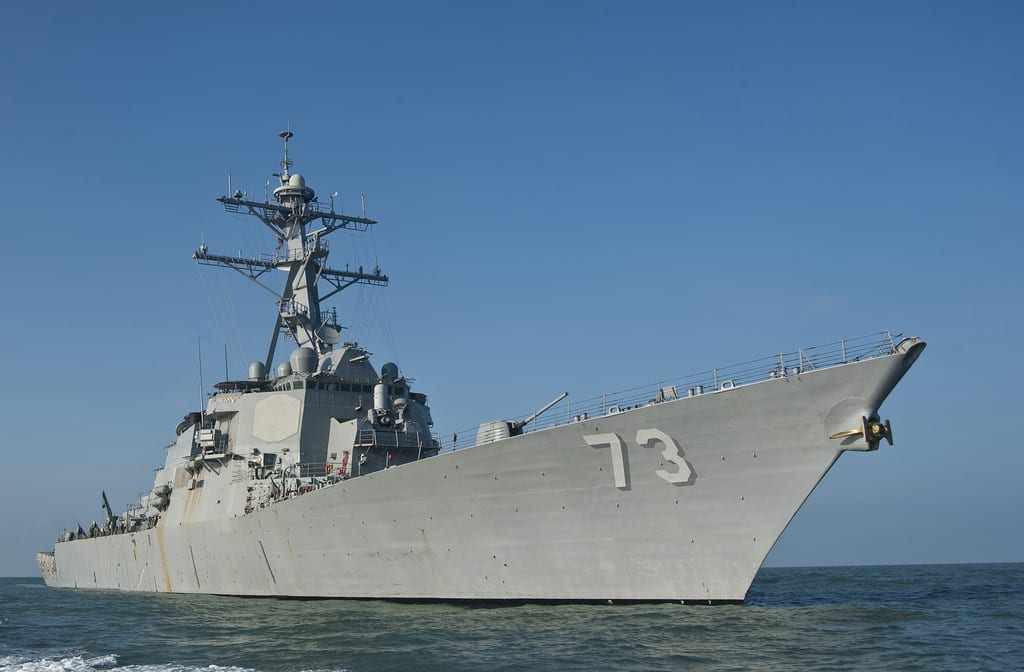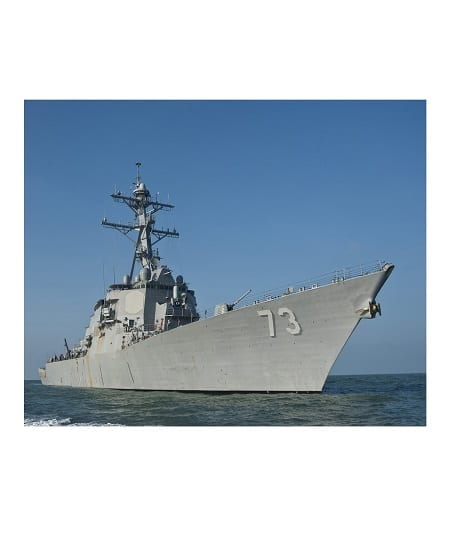
A Viewpoint on Tensions in the South China Sea
By Yehna Bendul, Research Staff Assistant, Sigur Center for Asian Studies
On October 2nd, a Chinese destroyer came within 45 yards of an American destroyer, the USS Decatur, as it sailed near disputed islands in the South China Sea. This near collision reflects increased tensions between the United States and China which show little to no signs of de-escalating anytime soon. This trend warrants an update on the South China Sea situation and an examination of U.S. strategy in the region.
The near collision of destroyers is only one close-call in a series of events which have increased tensions between the United States and China in recent months. Towards the end of September, the United States flew B-52s over the South China Sea despite knowledge that such activities usually upset Beijing. Washington also sanctioned the Chinese military on September 20th after China purchased Russian fighter jets and surface-to-air missile equipment, citing a violation of the 2017 Countering America’s Adversaries through Sanctions Act. These sanctions follow a trade war which has so far resulted in the United States imposing tariffs on about 40% of Chinese exports worth hundreds of billions of dollars. Chinese Foreign Ministry spokesman Geng Shuang responded that China was “strongly outraged by these unreasonable actions” and retaliated with sanctions of its own.
The most recent point of contention between the United States and China is the Pentagon’s decision to sail two U.S. warships through the Taiwan Strait on October 22nd. Chinese Foreign Ministry spokesman Lu Kang stated that the United States should “correct its mistakes and stop any official contact, military ties, and arms sales to the Taiwan region.” While Washington only has unofficial diplomatic relations with Taiwan, it serves as Taiwan’s main source of arms. However, Pentagon spokesman Colonel Rob Manning responded that Chinese frustration was unwarranted as “the ships’ transit through the Taiwan Strait simply demonstrates the U.S. commitment to a free and open Indo-Pacific,” and that “the U.S. Navy will continue to fly, sail, and operate anywhere international law permits.”
The consequences of increased tensions has been a breakdown in military, diplomatic, and economic cooperation between the United States and China. In May, Washington disinvited the Chinese navy from taking part in a multinational naval exercise known as Rim of the Pacific, or RIMPAC. While President Obama considered withholding a Chinese invite to RIMPAC in 2016, this is the first time China has not participated since its first invite in 2014. In October, China abruptly cancelled an annually scheduled security meeting with U.S. Defense Secretary Jim Mattis shortly after calling off trade talks in Washington. Given that degradation of relations does not seem to be slowing, the United States should examine its priorities in the region and craft a clear strategy to prevent further escalation of conflict.
Before choosing a strategy, however, the United States needs to resolve debate on whether the South China Sea is even a matter of American national interest. Robert Farley, senior lecturer at the Patterson School of Diplomacy and International Commerce, posits that U.S. interests in the region are not particularly strong. He argues that the Chinese island installations are of “negligible economic value” to the United States, that conflict poses no real threats to maritime trade patterns, and that the the South China Sea has no direct military value. While Washington has commitments to regional allies, Farley adds that it inadequately fulfills these commitments as U.S. forces are at “a disadvantage more here than almost anywhere else on Earth” given the close proximity of Chinese aircrafts, missiles, and land forces. Consequently, he believes that the United States has no useful negotiating position and has to be willing to compromise some of its goals in the region.
Professor Joseph Liow from Nanyan Technological University supports the other side of the debate and argues that oil and natural gas deposits, threats to the principle of freedom of navigation, and security risks posed by Chinese domination in the region make conflicts in the South China Sea significant matters of national interest. However, he adds that the current U.S. strategy is neither coherent nor adequate to satisfy U.S. goals. One potential action that the United States can take in the South China Sea is increasing military support of ASEAN initiatives. This is distinct from current U.S. actions of increasing its own military presence, as it would send the message that the United States is a non-claimant who values the perspectives and internationally codified claims of other countries. Along this line, Washington could more strongly signal its support for international law by ratifying the United Nations Convention of the Law of the Sea (UNCLOS). Lastly, Professor Liow posits that the United States could be more careful with its use of economic sanctions and incentives by synchronizing them with diplomatic and military actions.
The Center for Strategic and Budgetary Assessments proposes a litany of other options that the United States could choose from with respect to the South China Sea. However, it agrees with both Robert Farley’s and Professor Liow’s underlying argument that current U.S. escalations of military operations are worthless without some larger cohesive strategy that seriously weighs U.S. values against potential costs of aggravating China. Therefore, it’s clear that the U.S. needs to decide on its priorities and clearly delineate a strategy to avoid misunderstandings with China and reduce tensions in the region.
 Yehna Bendul is a sophomore in the Elliott School studying Philosophy and International Affairs with a concentration in international politics. She is currently studying Spanish but is also interested in U.S. relations with East Asia. In her position as Research Assistant with the Sigur Center, Yehna hopes to learn more about other regions of Asia and develop a more holistic understanding of the continent.
Yehna Bendul is a sophomore in the Elliott School studying Philosophy and International Affairs with a concentration in international politics. She is currently studying Spanish but is also interested in U.S. relations with East Asia. In her position as Research Assistant with the Sigur Center, Yehna hopes to learn more about other regions of Asia and develop a more holistic understanding of the continent.
Image: The guided-missle destroyer USS Decatur (DDG 73) transits off the coast of Bangladesh during Cooperation Afloat Readiness and Training (CARAT) 2012. Picture taken September 20, 2012. Sean Furey/ U.S. Navy/ Released


